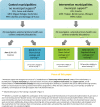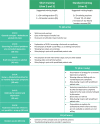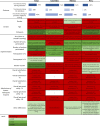Training primary health care providers in Colombia, Mexico and Peru to increase alcohol screening: Mixed-methods process evaluation of implementation strategy
- PMID: 37091075
- PMCID: PMC9924276
- DOI: 10.1177/26334895221112693
Training primary health care providers in Colombia, Mexico and Peru to increase alcohol screening: Mixed-methods process evaluation of implementation strategy
Abstract
Background: Initial results from the SCALA study demonstrated that training primary health care providers is an effective implementation strategy to increase alcohol screening in Colombia, Mexico and Peru, but did not show evidence of superior performance for the standard compared to the shorter training arm. This paper elaborates on those outcomes by examining the relationship of training-related process evaluation indicators with the alcohol screening practice.
Methods: A mix of convergent and exploratory mixed-methods design was employed. Data sources included training documentation, post-training questionnaires, observation forms, self-report forms and interviews. Available quantitative data were compared on outcome measure - providers' alcohol screening.
Results: Training reach was high: three hundred fifty-two providers (72.3% of all eligible) participated in one or more training or booster sessions. Country differences in session length reflected adaptation to previous topic knowledge and experience of the providers. Overall, 49% of attendees conducted alcohol screening in practice. A higher dose received was positively associated with screening, but there was no difference between standard and short training arms. Although the training sessions were well received by participants, satisfaction with training and perceived utility for practice were not associated with screening. Profession, but not age or gender, was associated with screening: in Colombia and Mexico, doctors and psychologists were more likely to screen (although the latter represented only a small proportion of the sample) and in Peru, only psychologists.
Conclusions: The SCALA training programme was well received by the participants and led to half of the participating providers conducting alcohol screening in their primary health care practice. The dose received and the professional role were the key factors associated with conducting the alcohol screening in practice.Plain Language Summary: Primary health care providers can play an important role in detecting heavy drinkers among their consulting patients, and training can be an effective implementation strategy to increase alcohol screening and detection. Existing training literature predominantly focuses on evaluating trainings in high-income countries, or evaluating their effectiveness rather than implementation. As part of SCALA (Scale-up of Prevention and Management of Alcohol Use Disorders in Latin America) study, we evaluated training as implementation strategy to increase alcohol screening in primary health care in a middle-income context. Overall, 72.3% of eligible providers attended the training and 49% of training attendees conducted alcohol screening in practice after attending the training. Our process evaluation suggests that simple intervention with sufficient time to practice, adapted to limited provider availability, is optimal to balance training feasibility and effectiveness; that booster sessions are especially important in context with lower organizational or structural support; and that ongoing training refinement during the implementation period is necessary.
Keywords: alcohol; depression; implementation; middle-income; primary health care; process evaluation; screening; training.
© The Author(s) 2022.
Conflict of interest statement
The author(s) declared no potential conflicts of interest with respect to the research, authorship, and/or publication of this article.
Figures
Similar articles
-
Factors associated with primary health care providers' alcohol screening behavior in Colombia, Mexico and Peru.Subst Abus. 2021;42(4):1007-1015. doi: 10.1080/08897077.2021.1903658. Epub 2021 Apr 13. Subst Abus. 2021. PMID: 33849396
-
Perceived appropriateness of alcohol screening and brief advice programmes in Colombia, Mexico and Peru and barriers to their implementation in primary health care - a cross-sectional survey.Prim Health Care Res Dev. 2021 Jan 28;22:e4. doi: 10.1017/S1463423620000675. Prim Health Care Res Dev. 2021. PMID: 33504413 Free PMC article.
-
Primary care-based screening and management of depression amongst heavy drinking patients: Interim secondary outcomes of a three-country quasi-experimental study in Latin America.PLoS One. 2021 Aug 5;16(8):e0255594. doi: 10.1371/journal.pone.0255594. eCollection 2021. PLoS One. 2021. PMID: 34352012 Free PMC article.
-
Tailoring an evidence-based clinical intervention and training package for the treatment and prevention of comorbid heavy drinking and depression in middle-income country settings: the development of the SCALA toolkit in Latin America.Glob Health Action. 2022 Dec 31;15(1):2080344. doi: 10.1080/16549716.2022.2080344. Glob Health Action. 2022. PMID: 35867541 Free PMC article.
-
[Toward a model of communications in public health in Latin America and the Caribbean].Rev Panam Salud Publica. 2005 Dec;18(6):427-38. doi: 10.1590/s1020-49892005001000006. Rev Panam Salud Publica. 2005. PMID: 16536929 Review. Spanish.
Cited by
-
Developing and Testing an Evaluation Framework for Collaborative Mental Health Services in Primary Care Systems in Latin America.Community Ment Health J. 2024 Apr;60(3):426-437. doi: 10.1007/s10597-023-01186-y. Epub 2023 Oct 10. Community Ment Health J. 2024. PMID: 37815700 Review.
References
-
- Anderson P., Bendtsen P., Spak F., Reynolds J., Drummond C., Segura L., Keurhorst M. N., Palacio-Vieira J., Wojnar M., Parkinson K., Colom J., Kłoda K., Deluca P., Baena B., Newbury-Birch D., Wallace P., Heinen M., Wolstenholme A., van Steenkiste B., … Gual T. (2016). Improving the delivery of brief interventions for heavy drinking in primary health care: Outcome results of the optimizing delivery of health care intervention (ODHIN) five-country cluster randomized factorial trial. Addiction, 111(11), 1935–1945. 10.1111/add.13476 - DOI - PubMed
-
- Anderson P., Manthey J., Jané-Llopis E., Natera Rey G., Bustamante I. V., Piazza M., Aguilar P. S. M., Mejía-Trujillo J., Pérez-Gómez A., Rowlands G., Lopez-Pelayo H., Mercken L., Kokole D., O’Donnell A., Solovei A., Kaner E., Schulte B., de Vries H., Schmidt C., … Rehm J. (2021). Impact of training and municipal support on primary health care–based measurement of alcohol consumption in three Latin American countries: 5-month outcome results of the quasi-experimental randomized SCALA trial. Journal of General Internal Medicine, 36, 2663–2671. 10.1007/s11606-020-06503-9 - DOI - PMC - PubMed
-
- Anderson P., Wojnar M., Jakubczyk A., Gual A., Segura L., Sovinova H., Csemy L., Kaner E., Newbury-Birch D., Fornasin A., Struzzo P., Ronda G., Van Steenkiste B., Keurhorst M., Laurant M., Ribeiro C., Do Rosário F., Alves I., Scafato E., … Kolsek M. (2014). Managing alcohol problems in general practice in Europe: Results from the European ODHIN survey of general practitioners. Alcohol and Alcoholism, 49(5), 531–539. 10.1093/alcalc/agu043 - DOI - PubMed
-
- Bandura A. (1977). Self-efficacy; toward a unifying theory of behavioural change. Psychological Review, 84(2), 191–215. - PubMed
LinkOut - more resources
Full Text Sources
Research Materials




